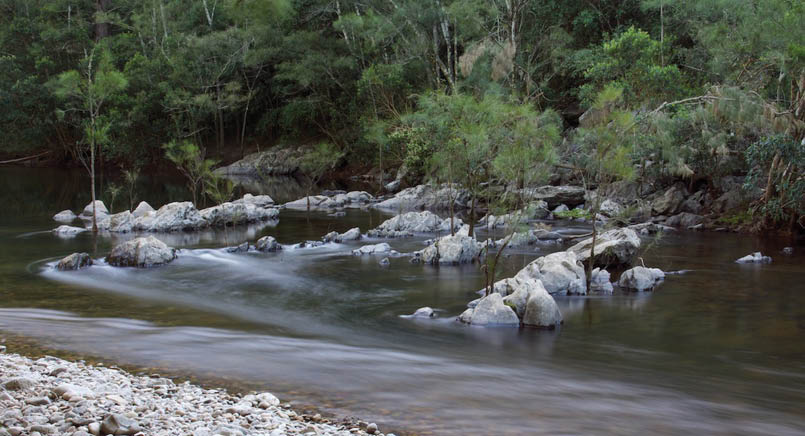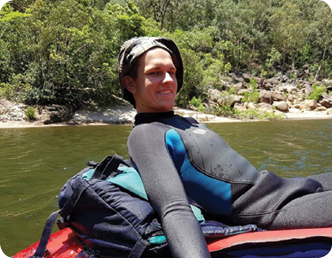


Protecting Australia’s wild rivers was a seminal time in the nation’s environmental consciousness. The Franklin River campaign of the 1980s saw the nation come together to save Tasmania’s unique wild rivers and wilderness areas. Unfortunately, some of Australia’s most pristine wild rivers are again under threat. Warragamba Dam, located adjacent to the Greater Blue Mountains World Heritage Area, is Sydney’s primary water supply. Like the Franklin River dam, the proposal to increase the height of Warragamba Dam wall will have devastating environmental impacts.
Lower Kowmung River David Noble
Dam Madness
Harry Burkitt

44 | BWA December 2017


The dam forms Lake Burragorang which can hold 2000 gigalitres of water, equivalent to four Sydney Harbours. Lake Burragorang currently inundates large areas of the Burragorang, Coxs, and Kedumba Valleys.
In June 2016, then NSW Premier Mike Baird announced that the Warragamba Dam wall would be raised by 14 metres for flood mitigation. The cost of the project was said to be close to $1 billion, with cost blow-outs likely given the record of many government infrastructure projects.
There is a very good reason why large dams have not been built in NSW for the last 30 years. By their very nature, dams have devastating impacts on the natural environment. Unfortunately, from time to time, governments still see political opportunity in announcing environmentally destructive dam projects when viable alternatives are available. The raising of Warragamba Dam wall typifies such political opportunism.
Damming destructionWhile at first glance a 14 metre raising may seem small, the increased height of the dam would hold 1000 gigalitres of water - the equivalent of an additional two Sydney Harbours on top of the existing dam. It would inundate and destroy 1000 hectares of the Greater Blue Mountains World Heritage Area, 4700 hectares of national parks, and
1800 hectares of declared Wilderness Area. Five kilometres of the Kowmung River, one of NSW’s few remaining wild rivers, will be frequently drowned under Lake Burragorang.
These precious and highly protected landscapes would be submerged for months at a time. Some of our most-loved Blue Mountains bushwalking destinations, including the Kedumba Valley, would be scarred by a permanent ring of weeds and sediment.
The denuded sediment ring would be visible from Echo Point, Katoomba, home of the iconic Three Sisters. The raised dam would irreparably damage World Heritage Listed environments and put the Blue Mountains’ $400 million a year tourism industry at risk.
The Government is embarking upon an engineer’s solution to what is a complex problem. Raising Warragamba Dam wall will not eliminate flooding downstream. The Warragamba River makes up only half of the Hawkesbury-Nepean Valley catchment area. Water originating from the south-eastern and northern half of the catchment would still cause flooding.
Lower Kowmung River David Noble
“These precious and highly protected landscapes would be submerged for months at a time.
BWA December 2017 | 45


Garmin Oregon 650 near Mt RufusWeiyun Yu
Flawed reasoningSo, why is the government embarking upon such an expensive, ineffective and environmentally destructive project? We know from recent statements by Water Utilities Minister, Don Harwin, that the NSW Government plans to open 2355 hectares of downstream floodplains to property developers. The property developers want to build sprawling new suburbs across the Hawkesbury-Nepean floodplains. This is a seriously dangerous idea.
Property developers think that raising Warragamba Dam will allow them to falsely claim that the thousands of new houses they build will be safe from flooding. Floods are a natural and unstoppable phenomenon in the valley. Raising Warragamba Dam will by no means stop floods from happening. At best, a raised dam wall would marginally reduce the height of some floods. Building houses on floodplains puts thousands of lives at risk.
In terms of managing floods in existing suburbs, flood levee construction, pre-flood release of dam waters and improved evacuation routes are all alternative options which can be implemented at less cost, while not destroying parts of one of the most protected natural landscapes in Australia. It’s simply a no brainer.
Australia’s international world heritage obligations cannot be a secondary consideration to an ill-considered dam proposal. The NSW and Australian Governments risk international embarrassment and ridicule if the dam raising proceeds. Rare eucalypt and dry rainforest communities found nowhere else in the world would die from sedimentation, erosion and weed invasion. At least 29 endangered and critically endangered native plant and animal species are found in the proposed destruction zone. A raised dam would put their very existence at risk.
Downstream environmental damage would follow the raising of the dam wall. Longer duration floods would cause river bank
erosion, resulting in a wider and shallower Hawkesbury-Nepean River. Downstream wetlands such as Bakers Lagoon depend on natural floods for nutrient replenishment. These wetlands and their associated wildlife populations would deteriorate.
Protecting cultureMany Indigenous cultural sites would also fall victim to any raise of the Warragamba Dam wall. The Burragorang Valley was home to the Gandangara people long before Warragamba Dam flooded the valley in 1960. The dam drowned large parts of their land and precious cultural sites. We do not need to repeat this story of destruction with the remaining cultural sites in the rest of the valley.
ActionAustralian history tells us that only people power can stop destructive dam projects. Please, in the coming months, join with us to be part of a growing campaign to save our irreplaceable Blue Mountains World Heritage rivers. Head to Don't Raise the Dam to sign up, donate and spread the word about the campaign.
Harry is a keen bushwalker and devoted conservationist. He began his journey in environmental advocacy in the campaign to save the internationally significant Cliefden Caves from destruction by a proposed dam. Harry now coordinates the Colong Foundation’s Blue Mountains Wild Rivers campaign and sits on the NSW Nature Conservation Council executive board. He is also a part-time history and geology student at the University of Sydney.
“Rare eucalypt and dry rainforest communities found nowhere else in the world would die ...
46 | BWA December 2017